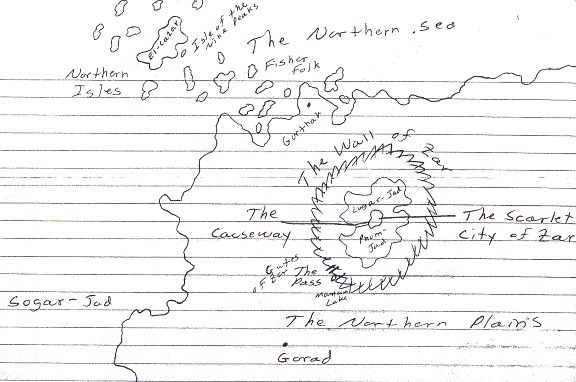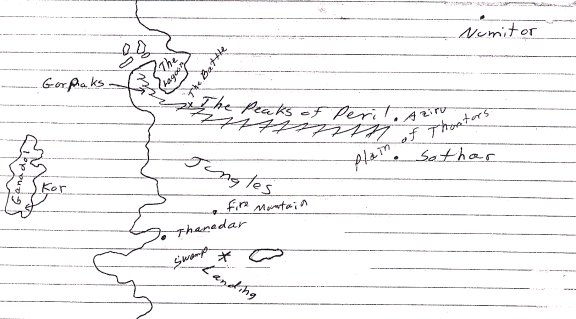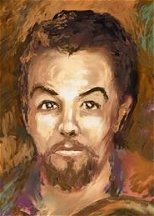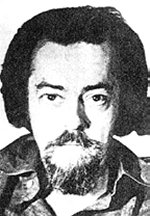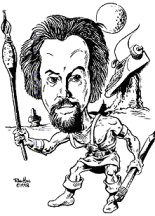Journey to the Underground
World
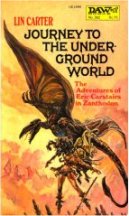 I started "Journey
to the Underground World" today and I'm in heaven! It's been about three
years since my last read and I needed this.
I started "Journey
to the Underground World" today and I'm in heaven! It's been about three
years since my last read and I needed this.
Being a fan of the Dray Prescot Saga by Ken Bulmer and the Josh Kirby
illustrations, I was pleased to see his work in this book. More as I come
to each one.
Published by DAW in November of 1979, I see no dedication and it should
have been Burroughs that got the nod, for this novel represents a distinct
nod to Pellucidar.
As to Eric Carstairs' age, the only (vague) reference so far is in the
"Editor's Note." Carter writes: "I have known Carstairs off and on for
several years. Although the rugged young adventurer is many years my junior,
we seem to have hit it off from the start." Lin was born in June of 1930
and was about 49 years old when he wrote "Journey." So, "many years" could
be anywhere from ten to thirty. Thus, Eric is somewhere between 19 and
39. I'd like to think 23, but he has seen so much action in the world prior
to these adventures in Zanthodon that he probably is older. Like I said,
vague.
I enjoyed Carter's "Editor's Note" overall but this line especially:
"...there are still lost lands in the remote corners of the earth where
fantastic monsters roam, where chaste and beautiful women remain to be
rescued from sneering villains, and where adventure and peril and heroism
thrive amid exotic and bizarre scenery." What more could I ask for!
One thing I was bothered by (big time!) is that Lin provided no map
of the known areas of Zanthodon. Well, I made my own and though absolutely
out of scale and juvenile in quality, I find it helpful in my reads of
this series.
 I recalled that
there was a map of Zanthodon in The Dictionary of Imaginary Places
by Alberto Manguel & Gianni Guadalupi. On page 421 the map shows a
vastly different conception. For one, it shows the entire land mass surrounded
by the Sogar-Jad while I believe there was still unexplored land to the
east and thus was left off my map. Plus, the Northern Isles and El Cazar.
This may be due to only the first two or three books being referenced.
Still, I will consult both maps during my read and see if I am in error.
Perhaps I could put together a map that contains the best of both.
I recalled that
there was a map of Zanthodon in The Dictionary of Imaginary Places
by Alberto Manguel & Gianni Guadalupi. On page 421 the map shows a
vastly different conception. For one, it shows the entire land mass surrounded
by the Sogar-Jad while I believe there was still unexplored land to the
east and thus was left off my map. Plus, the Northern Isles and El Cazar.
This may be due to only the first two or three books being referenced.
Still, I will consult both maps during my read and see if I am in error.
Perhaps I could put together a map that contains the best of both.
Events begin in Port Said Egypt before moving to a desolate section
of the Sahara Desert. Eric Carstairs saves Professor Percival Penthesileia
Potter from thugs and they strike up a friendship and partnership for Potter
knows the location of one of the entrances to Zanthodon. Only this one
is ever disclosed but others (one at least) are referred to, later on in
the series.
There is much humor to be found and I for one appreciate it. On page
18, Potter and Carstairs spar on the professor's middle initial P. He alternates
between being "suspiciously reticent," giving "frosty, reproving glares"
and "clearing his throat and giving a sniff," I was amused.
On page 14, when Eric proposes a drink after their initial meeting,
Potter begs off but finally, for medicinal purposes only caves in with:
"Straight gin," he snapped to the waiter. "Gordon's, if you stock it; Boodle's
will do." Carstairs then opines that gin is gin and on that point I quite
disagree.
One last example of humor in "Journey" occurs on page 44 where Potter
had just declared that triceratops were vegetarians and this one starts
eating a pterodactyl Carstairs had just killed and then trees the duo,
looking for another meal. "Mostly vegetarians, eh?" I (Eric) said sarcastically.
Looking remarkably unhappy, the Professor made no comment."
The incredible descent to the Underground World is described on pages
29-33 and while not as detailed or fraught as that of David Innes and Abner
Perry, it still makes for brave reading as "Babe" the helicopter of Carstairs
wends its way ever deeper into the Earth's crust. But unlike Pellucidar,
Zanthodon is not at the Earth's core but in a huge cavern, about 100 miles
down, beneath the Sahara. Potter estimates (page 40) the size to be "about
five hundred miles by five hundred, almost perfectly circular. ...A quarter
of a million square miles."
Potter crashes "Babe" while Carstairs naps but the helicopter is not
totally wrecked. I had hoped that Eric would one day return for "Babe,"
repair her and fly across Zanthodon. It could not however, ascend back
through the volcanic tunnel to the 1000 foot mountain in the Sahara it
originated in (pages 39 & 41). Useless to want as it never happens!
It seems a blacksmith would be necessary to repair the broken rotor blade.
But what about the Corsairs of El-Cazar?
Edgar Rice Burroughs (Tarzan & Pellucidar), Jules Verne, King Kong
and "The Lost World" are referred to in scattering fashion throughout the
first 50 or so pages. Zanthodon stands proudly along side these staples
of lost worlds and heroic fantasy.
Echoing Burroughs, there is a battle between the (carnivorous) triceratops
and a wooly mammoth (pages 46-48) where the former is crushed to a pulp.
This battle is illustrated by Josh Kirby in the frontispiece and is supported
textually on page 47. The two beasts are a little to blurry for my taste
but our heroes come off well. The background work is top notch and primitive.
The Sea is reached on page 58 and I think I had assumed that "Babe"
had landed near a "lagoon" of this body of water but in retrospect, it
was probably a lake, though Carter refers to it (page 34) as either a "lagoon"
or a "wide river." Soon after it turns into a swamp. In any event, a plesiosaurus
rears out of the sea's depths (later revealed as the Sogar-Jad). Shades
of Pellucidar!
By page 61, Potter and Carstairs are captured by the Ape-Men of Kor
from the island of Ganadol and Eric was woefully unprepared for their chieftain's
attack. I know he'll do better as he gets to know the dangers of the Underground
World of Zanthodon.
It turns out the Neanderthals are known in Zanthodon as Drugars and
their slave-raiding party that netted Professor Potter and Eric Carstairs
is hurriedly heading back to their kingdom of Kor on the island of Ganadol
which lies on the Sogar-Jad.
Josh Kirby illustrates this slave coffle on page 67, the scene suitable
barbaric. Others held captive include several Cro-Magnon men and woman.
They are of the tribe or kingdom of Thandar and it is from the wrath of
its king (omad), Tharn that the Drugars flee, for the woman is Tharn's
daughter, Dayra. Included also from Thanadar are young Jorn the hunter
and the conniving chieftain Fumio. If this whole scene reminds you of At
the Earth's Core, it should, as Burroughs originated this scenario
first in that first book of Pellucidar.
Other similarities to ERB's Inner World are that it is Apemen (Drugars/Sagoths)
who are the slavers, both lands both lie in eternal sunshine and time is
recorded in "sleeps." Also, the term the Apemen use for the Cro-Magnons
is "panjan," similar to what the Sagoths called modern men, "gilaks." In
an un-Burroughs-like move, bodily functions are mentioned on page 69.
The Thanadarians had actually advanced to the Bronze Age though they
are often referred to as Cro-Magons, with thoughts of the Stone Age uppermost
in the reader's mind. Potter suspects that they arrived in Zanthodon 50,000
years ago, fleeing an Ice Age. But no date of the Neanderthal's arrival
is conjectured.
Concerning my map, it was revealed on page 66 that the Sogar-Jad was
to the left of the raiding party and I had assumed that they were traveling
north along the western coast of Zanthodon though I suppose it could have
been south on the eastern coast. Page 86 states that Thanadar is "down
coast from Kor." Strangely enough, it is not for this reason that the map
in "The Dictionary of Imaginary Places" differs from mine.
Their map is just so seemingly wrong on most accounts but I'll talk more
about that later.
Just as the Drugars began to herd their captives into dugouts, enroute
to Ganadol, Eric starts a slave revolt that frees the Thanadarians, but
at the cost of his own freedom. It is in the aftermath of the great escape
that Carstairs begins his unlikely friendship with the Drugar, Hurok, which
becomes one of the rocks that the five book saga is based on.
As Kirby shows on page 87, a yith (plesiosaurus) attacks the returning
Drugars and after Hurok severs Eric's bound hands (to give him a fighting
chance), the favor is returned when Carstairs saves the Apeman from certain
death by drowning. They make their way to shore but which, Kor's or the
mainland?
Meanwhile, Professor Potter is mortified when Darya strips prior to
bathing in a stream. His voice "rose a treble" as the princess (gomad)
appears suddenly nude before his asonished eyes and ultimately "uttered
a strangled croak" to accompany his retreat visually. Lin Carter handles
this scene very well with his brand of humor. The sight of her perfect
breasts jutting forth while doing the back float is too much for the secretly
observing Fumio and he knocks the professor out and begins to assault the
gomad of Thanadar...
Zanthodon
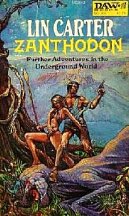 When
last I left Zanthodon, at the end of Journey to the Underground World,
Professor Potter had fainted by the shore of the Sogar-Jad. He had just
witnessed the abduction of Darya by Kairadine Redbeard and apparent death
of Jorn the Hunter. Eric Carstairs, Fumio, One-Eye, Xask and Tharn were
off on other separate but related adventures.
When
last I left Zanthodon, at the end of Journey to the Underground World,
Professor Potter had fainted by the shore of the Sogar-Jad. He had just
witnessed the abduction of Darya by Kairadine Redbeard and apparent death
of Jorn the Hunter. Eric Carstairs, Fumio, One-Eye, Xask and Tharn were
off on other separate but related adventures.
Near the end of Zanthodon, the second of five books in this latter
day series by Carter, all parties (and then some) have been happily reunited
and it seems a duology is all that is needed to relate the strange tale
of Eric Carstairs. Ah, but we know better!
During the 185 pages of action, the warriors of Thanadar and Sothar
destroy the dwarfish Gorpaks and their Lords the Sluagghs, while both Jorn
and Darya escape the pirate vessel the "Red Witch."
A comment or two on both of the above. On page 38, when Potter is confronted
by a stray Sluaggh, the five foot leech is described thusly: "But the
most horrible and repellant features about the monstrous leech was not
its size or its nature, but the uncanny gleam of cold, inhuman intelligence
that burned in its eyes." Aside from the hypnotic effect of those eyes
on its victims, the intelligence aspect is never fully explored. And aside
from gaining mastery over the Gorpaks and voicing a high-pitched wail when
being killed, I saw no actual intelligence displayed. Nor was the history
of the Gormaks and their relatively high level of civilization explained
and their docile slaves as well.
As Kairadine brings the Princess Darya to his cabin aboard the "Red
Witch," he prepares to rape her. While this act never occurs (thanks to
Jorn), Carter does get rather vivid in describing the set-up on page 33:
"As
she panted for breath, her perfect breasts rose and fell, their delectable
pink tips crisped from the coldness of the sea air on her damp skin. The
corsair let his eyes travel caressingly down the sleek curve of her arm
and shoulder, belly and flank and long, slim, tanned thigh." Burroughs
would never write such semi-erotic stuff (different era, for one thing)
and this Stone/Bronze Age Princess is continuously being abducted while
bathing nude in some secluded pool. Pretty sexy stuff! The illustration
on page 172 shows Darya's (nude) charms best, far better than Thomas Kidd's
cover art.
Kidd is credited with the Cover Art on the Copyright Page but on the
Title Page, he is credited as "Ilustrated by." But clearly, the interior
illustrator is different and far superior to Thomas Kidd. I just wish I
knew who to credit. Perhaps best of the lot is the Frontispiece, showing
Tharn as described on pages 14 & 15.
Going a step further than contemplative rape, Carter describes the actual
rape by a Gorpak on a pre-teen slave girl on page 79: "For suddenly
tossing aside the whip, the bald mane tore off his loin-clout and got down
on the floor atop the weeping little girl. The child made no protest against
the assault. The Professor could hear her muffled sobs beneath the hog-like
gruntings of the creature violating her." As disgusting as this scene
is, more so was her father's reaction to it on page 81. At least this rape
validates the total destruction of the Gorpaks and Sluagghs later on.
While temporarily the captive of One-Eye, Eric is unbound but still
doesn't simply run away from his much slower Drugar adversary (page 93).
Seems sort of silly for Carter not to realize this.
Another similarity between Zanthodon and Pellucidar is when Carter introduces
a homing instinct (page 102): "The people of Zanthodon have, by and
large, something akin to a homing sense: generally, they unerringly head
in the direction they want to go..." Seemed almost an add on by Carter.
A three page character glossary ends Zanthodon, complementing
the animal glossary at the end of the first book.
Just when things seem all sorted out, along comes Achmed the Moor to
kidnap Dayra once more and the Minoan warriors of Zar capture Eric, the
Professor and Xask. Everything has gone wrong but at least I know that
"Hurok of the Stone Age" will be ready for me!
Curiously, the Cro-Magnon's slang name for the Neanderthal's, Drugars
meaning Ugly Ones, is always capitalized but when they return the favor
and call the Cro-Magnons panjani, meaning smoothskins, it is not capitalized.
See page 16 for examples of usages.
The leaders of Sothar, Thanadar and Kor are usually referred to as High
Chief or Omad, with lesser Chieftains serving beneath (One-Eye, Fumio and
Komad for example). But sometimes the term King is used by Carstairs and
kingdom for tribe. In Pellucidar, David Innes created kingdoms out of the
federated tribes and kings of their chiefs. Perhaps Eric does the same
on his ascension to Emperor of Zanthodon.
I believe it is the information on page 18 that made me determine that
the Sogar-Jad lay to the west of the Zanthodon mainland: "We were moving
steadily west, toward the shores of the Sogar-Jad, with the jungle at our
left and the plains to our right."
On page 32, Darya is said to have no knowledge of the Barbary pirates
of El-Cazar, as they have never raided this far south from their island
stronghold to the north. Yet, (page 61), Jorn the Hunter knows enough to
refer to the corsairs as "The-Men-Who-Ride-Upon-Water" and I believe Tharn
did so as well, in the first book
Hurok of the Stone Age
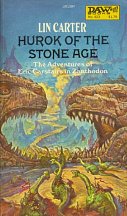 Lin
Carter continues to follow ERB's titling of his Zanthodon Series. Both
used the land nick names in the first book, the real names in the second
and both authors used supporting character names in books three and four.
Lin
Carter continues to follow ERB's titling of his Zanthodon Series. Both
used the land nick names in the first book, the real names in the second
and both authors used supporting character names in books three and four.
1. "At the Earth's Core" and "Journey to the underground World"
2. "Pellucidar" and "Zanthodon"
3. "Tanar of Pellucidar" and "Hurok of the Stone Age"
4. "Tarzan at the Earth's Core" and "Darya of the Bronze Age"
Speaking of whom, Darya is only mentioned a few times in passing during
Hurok
of the Stone Age and never appears. Our Princess will dominate the
fourth book which matches the third in time-line.
I hope the readers of this article don't mind my geographical comments
but I'm double checking the accuracy of my own map of Zanthodon and so
far it seems I'm right on, as far as the known areas of this inner world
continent are concerned. For it seems that Zanthodon is just that, a single
continent with some outlying islands. True, only the western and northern
coasts have been explored in the five books but Eric Carstairs himself
states (page 41) that "the Thandarians and Sotharians reached the point
at which the shoreline curves back upon itself, and found the northernmost
extremity of the continent." However, I also note that "Here a broad
arm of the underground sea extended like a natural barrier, making further
progress impossible. Along this arm of the Sogar-Jad were many small and
rocky islands, a veritable archipelago, in fact." Two pages earlier,
Carstairs comments that "the shoreline bulged outwards, curving back
upon itself farther to the north." I have shown "the bulge" and these
islands as well as El-Cazar but not the aforementioned "broad arm." It
is probably a wide bay as opposed to a gulf but why the party could not
continue, I can't explain. Sure the bay itself was an obstacle but why
not travel via the shoreline?
Another clue (page 16) that only western Zanthodon has been explored
by Lin Carter is that "Zar, lay inland from the coast, far to the east."
So really, we readers have no idea how vast Zanthodon actually is or how
many tribes exist beyond those already mentioned:
Thandar
Sothar
Gorpaks (exterminated)
Gorad (appear in this book)
Numitor (appear in this book)
Gorthak (appear in fourth or fifth book)
Fisher Folk (appear in fourth of fifth book)
Aziru (appear in fourth of fifth book)
Plus of course the Drugars of Kor on Ganadol, the Minoans of Zar on
the Lugar-Jad and the Barbary Pirates of El-Cazar, among the Northern Isles.
Conversely, Pellucidar is deeper within the Earth and much vaster. I'm
sure Abner Perry and Professor Potter could give the relative number of
square miles for each but Pellucidar has several continents (it seems,
though a full map could reveal that all the seas are actually landlocked
and part of the greater whole), thus rendering the Earth's Core having
one huge land mass as well. We may never know the true extent of both inner
earth worlds but maybe some day some intrepid soul(s) will push the boundaries
of both?
The Scarlet City of Zar is protected by a ring of mountains called the
Wall of Zar and an inland sea known both as the Lugar-Jad and the Pnom-Jad
(pages 46 - 48). Though described as the size of "one of the Great Lakes,"
there is a great island (upon which Zar is situated) that is "in the exact
center of the inland sea." Yet, Carstairs could easily discern the city
and its buildings from the shore and a stone causeway connects from there
to the island. Despite Minoan engineering, it is doubtful they could build
a bridge that traversed half of Lake Erie and the fact that Zar was easily
viewed from shore shows the Pnom-Jad (Little Sea) to be simply a very large
lake but certainly no "Great one.
And since we're here, on the Pnom-Jad, I wonder why it is so named when
the inhabitants on Zar speak ancient Minoan and would presumably have named
this "inland sea" upon taking control of it, about three thousand years
ago.
And why have the Minoans retained their language in whole? The Pirates
of El Cazar, a far more recent addition to Zanthodon, has already adopted
the almost universal language of the Cro-Magnons and Neanderthals (Drugars).
And why would Zar fear a barbarian invasion? They have the Walls of
Zar with only one pass readily available to an attacking horde, the Gates
of Zar, carved in the likeness of its living god, the Zorgazon or T-Rex.
Josh Kirby amply illustrates this on the cover, as Carstairs and Potter
are brought into captivity to Zar. The narrow pass beyond the Gates of
Zar shows itself to be easily defended against a numerically superior host.
Then there is the Pnom-Jad itslef, crossable only by boat or narrow causeway.
Thus far, only the far away Drugars of Kor seemed to have built primitive
boats and the Pirates of El-Cazar, with far superior ships. Yet, how could
either build a fleet on the shores of the inland sea, prior to assaulting
Zar itself? As to the causeway, it could be easily defended or destroyed
if need be.
Assuming that invaders could get this far, they'd still have to invade
the city proper and intense hand to hand fighting would result with the
Minoans reluctant to give up their lives, families and homes.
Yet, there is a fleet of merchant and war ships abroad on the Pnom-Jad.
With whom do they trade as no mention of coastal settlements is made and
with whom would they fight? Who would dare or be capable of attacking the
Scarlet City of Zar?
My last piece of geographical data pertains to the so-called "mountain
lake" that Jorn falls into (pages 111 & 112) during a landslide in
the Wall of Zar. It lies at the base of a mountain on the edge of the Northern
Plains so technically it is a "lake close to a mountain."
Carstairs constantly refers to the people of Sothar and Thanador as
Cro-Magnons but are they really? They migrated to Zanthodon perhaps ten
thousand years ago (Potter could tell you), as Cro-Magnons but might they
not have evolved into true Homo Sapiens as evidenced by the ascent
of these two tribes (at least) through the Copper Age into that of
the Bronze? Speaking of which, though daggers, spears and bow and arrows
have been invented, why not swords? If bronze or copper are readily available
would not a sword be the logical next step, up from the smaller dagger?
I just noticed on page 89 that Carter (for once at least), refers to
the Sotharian and Thanadorians as "a hardy race, these direct descendants
of our own Cro-Magnon ancestors."
On page 48, Captain Raphad reveals that Zar is in decline, population-wise
as "the number of our births is far less than the number of deaths."
Why this is, I don't know but does this mean that given sufficient time,
Zar will fade into oblivion, invasion or not? Perhaps inbreeding is a probable
and if so, why not utilize their robust Cro-Magnon slaves to add fresh
blood and genes to that of the decadent Minoans?
Though the primitive nations of Sothar and Thanadar are far below the
level of civilization represented by Zar, both are in the Bronze Age (page
82). No iron in Zanthodon? I'll wait to see if the Barbary Pirates have
iron. The late and unlamented Gorpaks were of the Bronze Age also. A pity
their past was not fully examined by Carter as they were somewhere between
Zar and the two barbarian nations of Thanadar and Sothar, as far as level
of civilization was concerned. It is not clear (at this time) whether or
not the tribes of Gorad, Numitor or Gothak have advanced out of the Stone
Age. It is curious that the tribes of Sothar and Thanadar never interacted
with those of Numitor or Gorad. The latter two are located "far to the
south" of Zar (page 173) apparently still north of the Peaks of Peril.
Despite this natural barrier, I would think that with the thousands of
years spent in Zanthodon by these tribes it would result in some sort of
discovery of each other. On page 185, Garth of Sothar recognizes the warriors
fleeing Zar as those of Numitor and Gorad.
Of note to fans of Edgar Rice Burroughs, Lin Carter utilizes the concept
of primitive or alien worlds being unaware of the art of pugilism (page
67) and Carstairs narrowly escapes "A Fate Worse Than Death" at the hands
of Empress Zarys (page 171).
Speaking of whom, not only does she look almost exactly like Darya,
their names are darn close as well. But the Empress is a bit older and
far more sensuous, as evidenced by her sexual fondling of Eric's pistol
(page 109) and the general parading of her painted nipples and nude nether
regions. Total flaunting!
I was under the impression that only a handful of the tribe of Sothar
were enslaved by the Gorpaks, with the balance destroyed by the earthquake
which drove them from their ancestral home. How else but with small numbers
could the warlike Sotharians be captured by the relatively weak (militarily)
Gorpaks? Yet, they are said to be numbered in the hundreds when they eventually
split from the Thanadarians and when Captain Raphad spots them while on
patrol (pages 89 & 106).
Carter does go where Burroughs did not, in terms of explicit sexual
scenes or possibility. The chance of "a bit of gang rape" on Ialys
(slave girl of the Empress), is pondered by Carstairs on page 174. That
and the pistol barrel fondling by Zarys is pretty explicit for this sort
of tale.
I've already mentioned Josh Kirby's great cover art but his interiors
deserve attention as well. The Frontispiece represents an exaggeration
of the scene on page 35. A thirty foot snake does not tower over its victims
like this xunth does. Still it is effective.
On page 64 Kirby thankfully shows Yualla as he wants and not as Carter
describes. Here we see curves upon curves upon curves as opposed to the
slender cave girl of carter. The thakdol is nicely drawn but the vandar
on page 123 is even more so. And here we see yet more of Yualla's delightful
charms.
The journey through the sewers of Zar is rather poorly illustrated on
page 158, as this illustration is "too busy." Here, Empress Zarys is referred
to as the "Witch Queen of Zar." Is she a witch? I've seen no indication
though she might be considered a goddess by her subjects. Is she a Queen
or Empress? Since she rules only the lands and seas within the Walls of
Zar and the nearby approaching Northern Plains, it seems that Queen is
more appropriate, since there are no conquered tribes to rule over, on
to raid for fresh slaves. But perhaps the title is ancestral, from ancient
Crete when they did rule an empire in the eastern Mediterranean?
The last interior is of Zorgazon (T. Rex) on page 179 and is a dramatic
one at that, with a human dangling in its great jaws. But do we ever sea
another such beast, even an allosaurus, in Zanthodon?
Plot-wise, Hurok of the Stone Age is made up of the stories of
Garth searching for his daughter Yualla, Tharn like-wise searching for
Darya (they both were carried off by thakdols), and Hurok searching for
Carstairs and Potter. By books end, we know that Darya is aboard a Barbary
Pirate ship headed for El Cazar while the host of Sothar and a smattering
of tribesmen from Numitor and Gorad is heading towards the northwest
coast of Zanthodon to unite with those of Thanadar. Yualla is rescued as
well as Eric and the Professor, though Garth is sorely wounded.
If there is one impression I am left with by this incredible Lin Carter
novel, it is the words of Eric Carstairs describing what Hurok had accomplished
during his adventures (page 192). "Sometimes, in dire adversity, men
break. Other men, however, pass through the fire and emerge strong, tempered,
like steel passing through a smith's forge. And thus had been the fate
of my old friend and comrade-in-peril, Hurok of the Stone Age."
Well written, Lin!
Next up, "Darya of the Bronze Age" and Zanthodon's version of Korsar!
Darya of the Stone Age
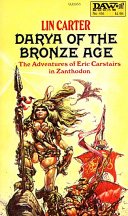 Darya
of the Bronze Age is the fourth of five books in Lin Carter's Zanthodon
Series. Timeline-wise it runs concurrently with events previously described
in Hurok of the Stone Age.
Darya
of the Bronze Age is the fourth of five books in Lin Carter's Zanthodon
Series. Timeline-wise it runs concurrently with events previously described
in Hurok of the Stone Age.
For the most part, this book reveals the fate of Darya after she was
kidnapped (for the second time), by Kairadine, Prince (though there is
no king to be the son of) of El-Cazar. It is not Eric Carstairs who rescues
her. It is her father Garth, King of the Sotharians. He and his Cro-magnon
horde invade and temporarily conquer the Barbary Pirate's island stronghold,
out in the Northern Seas.
Making their way back to the mainland they eventually rejoin the tribe
of Thandar, just after they (Tharn and company) have defeated both the
avenging pirates and Minoan Cretans of the Scarlet City of Zaar. Sadly,
the battle was won far too easily in a contrived manner. Lin could have
done better with this and added a touch of realism in the process.
By book's (and battle's) end, the buccaneers and Minoans are returning
to El-Cazar and Zaar, defeated and disarmed, while Kairadine has mistakenly
kidnapped Zarys, Empress of the Minoans. Eric and Darya are once again
reunited and their union has been blessed by Tharn.
So now what? Most loose ends (but for Kairadine and Zarys) have been
resolved or so it seems. After all, the reader is informed of the fifth
book, Eric of Zanthodon. No mention of it being the last book in
the series is made.
Josh Kirby is only credited with the cover art but he did the five interiors
as well. A voluptuous Darya adorns the cover and is just busting out with
curves, thankfully so, unlike how Lin describes her.Josh does well with
the interiors but they are not as good as the cover. I suspect his "busy"
style does not transfer all that well in some instances. In fact, I will
soon conduct an Internet search and see if he has a collection available,
one that will portray his gifted talents to best advantage.
An interesting comment is made by Carstairs on page 33. "... beyond
the shore lay further islands, large and small, drowned in veils of floating
mist, beyond which stretch, presumably, the unbroken sea to the very walls
of the cavern-world." What a visual. Imagine actually reaching the
edge of Zanthodon and coming upon the encompassing wall? This makes me
wonder at what the "roof" of the Underground World looks like from the
ground. Carter has addressed this but only briefly, such as when Eric and
the Professor first crash landed through the volcano shaft. But how high
up is the "ceiling" and what is its appearance. For some reason I visualize
ERB's inner Lunar world (Vega?), with many openings to the surface.
And again, I am prompted to think of Pellucidar and how there is no
ceiling, only the far side of the Earth's Core. Though not visible to its
inhabitants, the concept just floors me!
Funny how the ocean surrounding Zanthodon is known as Sogar-Jad and
the inner sea as Pnom or Lugar Jad, but the portion of the Sogar-Jad by
El-Cazar and the Northern Isles is simply called the Northern Sea (page
35). This is one type of lack of consistency I noticed in this book and
I'm a bit disapponted in this because Lin has written on how such tales
should be crafted and the pitfalls to avoid. Never mind that he didn't
provide a map, breaking rule #1.
Another example is on whether or not Fumio of Thandar is a coward. Usually
it is said that he is, but occasionally we are informed otherwise, like
on page 110.
And is Achmed a Moor (as he usually is) or a Turk as on page 37.
I guess there are more than Arabs (of the Algerian variety, mainly)
and Moors as Kemal the Turk and Haroot the Persian make brief appearances
on page 36.
There is some un-Burroughs-like sexuality in this book, particularly
when Zoraida fondles Darya's breasts as she hangs helpless. Plus the girls
seem to like raking their nails across the breasts of each other while
earlier engaged in a cat fight. The threat of gang rape (page 71) is very
real but thankfully never happens. Talk of Kairadine "mounting" Darya (page
52) is a bit risque as well. A different cup of tea, is Zanthodon to Pellucidar!
The story still reads well and I do look forward to events in the concluding
novel, but honestly, my appreciation of Burroughs rises after this reading.
Eric of Zanthodon
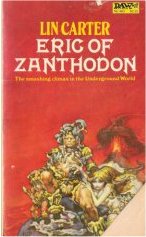 One train of
thought (or word, actually) that stayed with me throughout my latest re-read
of Lin Carter's Eric of Zanthodon was "anti-climatic." I remember
thinking that "Darya of the Bronze Age" would have made an appropriate
conclusion to the Underground World saga, save for a few loose ends. Well,
those loose ends are resolved in this book but I feel 176 pages was about
100 too many for this purpose. Does that mean I thought this novel a poor
one? No, just the weakest in an extremely fine series.
One train of
thought (or word, actually) that stayed with me throughout my latest re-read
of Lin Carter's Eric of Zanthodon was "anti-climatic." I remember
thinking that "Darya of the Bronze Age" would have made an appropriate
conclusion to the Underground World saga, save for a few loose ends. Well,
those loose ends are resolved in this book but I feel 176 pages was about
100 too many for this purpose. Does that mean I thought this novel a poor
one? No, just the weakest in an extremely fine series.
Published by DAW Books (No. 362) in May of 1982, it represents the culmination
of Carter's homage to Edgar Rice Burroughs' Pellucidar series. Begun
in November of 1979, the five volumes of Zanthodon were published over
a two and a half year period, as compared to the forty-nine for ERB's Inner
World novels. Whereas Carter plotted his series in advance and in detail,
before actually beginning to write, Burroughs went wherever his fertile
imagination took him, after the opening duology.
I can imagine how exciting it must have been for Barsoom and Pellucidar
fans to wonder when the next beloved book in their series would appear
next, as both of them had a fifty year publishing span with no discernable
pattern. With Carter, one need not worry as he had a "plan" for Zanthodon
as well as The Green Star and World's End series. Five books (discounting
Giant
of World's End) and out! Other series like Callisto, Thongor and the
Great Imperium had "other plans," to be discussed at another time.
But, back to Eric of Zanthodon. Once again, featuring a Josh
Kirby cover and half a dozen interiors. The cover depicts the scene from
the last page, showing a barbaric Eric, shy son Gar and an absolutely curvacious
(erroneously so) Darya. The erupting volcano in the background was borrowed
from an earlier scene near the old village of Sothar.
Carstairs confirms beyond all doubt that my map of the
Underground World is basically correct, by stating in a footnote on
page 29 that the Sogar-Jad lay to the west of Thandar. Another addition
to Zanthodon is the remnant of the Aziru tribe from the African savannah.
Only Niema and Zuma have survived and they join Eric's tribe, along with
Baron Manfred Von Kohler, Private Borg and Corporal Schmidt, survivors
of a company of World War II Germans, retreating from the Allied advance
in the North African theatre. I had hoped that Carter would dwell a bit
on the ages of these warriors versus their younger appearance, somewhat
like Burroughs did with Ah-gilak in Savage Pellucidar. Both
inner worlds are essentially timeless, to a degree as the inhabitants have
not developed a way to measure time and wouldn't if they could. Abner Perry
did try though....
Another similarity between the two series is the homing instinct possessed
by the long-time inhabitants. The Barbary Pirates and Minoans of Zanthodon
don't possess it and I don't recall if the Korsars of Pellucidar do.
I had mentioned the tying up of loose ends by Carter but actually, two
are not. The fate of Kairadine Redbeard and Zarys of Zar is unknown as
is the future of their respective strongholds. Also, Murg is left to flee
from the justice of the Thandarian/Sotharian host, after knifing Xask in
the back. It was ever "Murg's way."
Speaking through Von Kohler, Lin Carter expresses his personal views
on how his Utopia would appear. "Would it not, Herr Carstairs, be a
worthy cause to devote our lives to, if we could spare the Cro-Magnon nation
the mistakes that have marred the history of our own Western civilization?
Extreme nationalism, imperialism, the exploitation of less advanced peoples,
the creation of poverty and slums, military aggression ... and, instead
of these, teach them the ways of justice, equality, fairness, decency,
toleration, brotherhood, cooperation, and -- freedom!"
By book's end, Eric Carstairs is proclaimed Omad of his tribe of Zanthodon
and future Omad of those of Thandar and Sothar, upon the deaths of Tharn
and Garth. In other words, the Omad-of-Omads or Emperor of Zanthodon.
It's too bad that Carter never continued this series by concentrating
on the unexplored eastern and extreme southern regions of the continent
of Zanthodon as well as overseas on the Sogar-Jad, beyond Gantatol, El
Cazar and the Northern Isles. But alas, unless some intrepid writer of
fan fiction undertakes this task, the future adventures of Eric Carstairs
will remain unwritten and unknown to us, readers of this sort of tale.


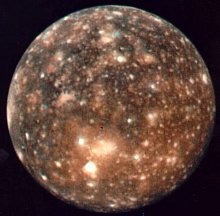

 I started "Journey
to the Underground World" today and I'm in heaven! It's been about three
years since my last read and I needed this.
I started "Journey
to the Underground World" today and I'm in heaven! It's been about three
years since my last read and I needed this.
 I recalled that
there was a map of Zanthodon in The Dictionary of Imaginary Places
by Alberto Manguel & Gianni Guadalupi. On page 421 the map shows a
vastly different conception. For one, it shows the entire land mass surrounded
by the Sogar-Jad while I believe there was still unexplored land to the
east and thus was left off my map. Plus, the Northern Isles and El Cazar.
This may be due to only the first two or three books being referenced.
Still, I will consult both maps during my read and see if I am in error.
Perhaps I could put together a map that contains the best of both.
I recalled that
there was a map of Zanthodon in The Dictionary of Imaginary Places
by Alberto Manguel & Gianni Guadalupi. On page 421 the map shows a
vastly different conception. For one, it shows the entire land mass surrounded
by the Sogar-Jad while I believe there was still unexplored land to the
east and thus was left off my map. Plus, the Northern Isles and El Cazar.
This may be due to only the first two or three books being referenced.
Still, I will consult both maps during my read and see if I am in error.
Perhaps I could put together a map that contains the best of both.
 When
last I left Zanthodon, at the end of Journey to the Underground World,
Professor Potter had fainted by the shore of the Sogar-Jad. He had just
witnessed the abduction of Darya by Kairadine Redbeard and apparent death
of Jorn the Hunter. Eric Carstairs, Fumio, One-Eye, Xask and Tharn were
off on other separate but related adventures.
When
last I left Zanthodon, at the end of Journey to the Underground World,
Professor Potter had fainted by the shore of the Sogar-Jad. He had just
witnessed the abduction of Darya by Kairadine Redbeard and apparent death
of Jorn the Hunter. Eric Carstairs, Fumio, One-Eye, Xask and Tharn were
off on other separate but related adventures.
 Lin
Carter continues to follow ERB's titling of his Zanthodon Series. Both
used the land nick names in the first book, the real names in the second
and both authors used supporting character names in books three and four.
Lin
Carter continues to follow ERB's titling of his Zanthodon Series. Both
used the land nick names in the first book, the real names in the second
and both authors used supporting character names in books three and four.
 Darya
of the Bronze Age is the fourth of five books in Lin Carter's Zanthodon
Series. Timeline-wise it runs concurrently with events previously described
in Hurok of the Stone Age.
Darya
of the Bronze Age is the fourth of five books in Lin Carter's Zanthodon
Series. Timeline-wise it runs concurrently with events previously described
in Hurok of the Stone Age.
 One train of
thought (or word, actually) that stayed with me throughout my latest re-read
of Lin Carter's Eric of Zanthodon was "anti-climatic." I remember
thinking that "Darya of the Bronze Age" would have made an appropriate
conclusion to the Underground World saga, save for a few loose ends. Well,
those loose ends are resolved in this book but I feel 176 pages was about
100 too many for this purpose. Does that mean I thought this novel a poor
one? No, just the weakest in an extremely fine series.
One train of
thought (or word, actually) that stayed with me throughout my latest re-read
of Lin Carter's Eric of Zanthodon was "anti-climatic." I remember
thinking that "Darya of the Bronze Age" would have made an appropriate
conclusion to the Underground World saga, save for a few loose ends. Well,
those loose ends are resolved in this book but I feel 176 pages was about
100 too many for this purpose. Does that mean I thought this novel a poor
one? No, just the weakest in an extremely fine series.
